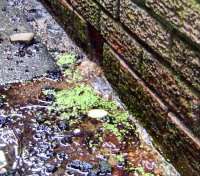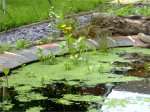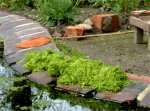| Features: Ponds |  |
Living with duckweed
I used to hate duckweed. I kept our old pond covered with a wire mesh to prevent accidents when our children were young. This meant that it was very difficult to get at the pond in order to do routine maintenance and the duckweed pretty much had its own way: it generally covered the whole pond, hiding most of the wildlife from view. It was while searching on the web for ways of combating it that I realised what an interesting plant it actually is.
The amazing facts The duckweed family contains what are thought to be the world's smallest flowering plants The duckweed family contains what are thought to be the world's smallest flowering plants The duckweed family contains what are thought to be the world's smallest flowering plants. Although normal seed (yes the worlds smallest fruit), can be produced, duckweed more commonly reproduces asexually by 'budding'. The leaves, often called fronds, can produce small buds which mature into replicas of the parent plant - often remaining attached to the parent until maturity is reached. Each plant of the common duckweed, Lemna minor has a single root. Research has shown that the root does not play such an important part in absorption of water and nutrients in to the plant (most of this is done by the underside of the frond) but probably acts as an 'anchor' to stabilise the plant in the water and perhaps as an aid to dispersal - the roots sticking to the feet and plumage of aquatic birds. The duckweed family contains what are thought to be the world's smallest flowering plants. Although normal seed (yes the worlds smallest fruit), can be produced, duckweed more commonly reproduces asexually by 'budding'. The leaves, often called fronds, can produce small buds which mature into replicas of the parent plant - often remaining attached to the parent until maturity is reached. Each plant of the common duckweed, Lemna minor has a single root. Research has shown that the root does not play such an important part in absorption of water and nutrients in to the plant (most of this is done by the underside of the frond) but probably acts as an 'anchor' to stabilise the plant in the water and perhaps as an aid to dispersal - the roots sticking to the feet and plumage of aquatic birds.
 Opportunism: duckweed growing in a puddle
I first began to respect the resourcefulness of duckweed when I found it growing more than a year ago in a damp, dark passageway along the side of my house where virtually nothing else grows. It was inhabiting nothing more than a puddle, perhaps one millimetre or so deep, and must have been transferred there on my feet from my old pond. The puddle is practically a permanent feature because of the way water drains from surrounding properties, but during the near-drought we had during March and April this year, the puddle dried out (for the first time in my experience). I supposed that was the end of the duckweed colony, Opportunism: duckweed growing in a puddle
I first began to respect the resourcefulness of duckweed when I found it growing more than a year ago in a damp, dark passageway along the side of my house where virtually nothing else grows. It was inhabiting nothing more than a puddle, perhaps one millimetre or so deep, and must have been transferred there on my feet from my old pond. The puddle is practically a permanent feature because of the way water drains from surrounding properties, but during the near-drought we had during March and April this year, the puddle dried out (for the first time in my experience). I supposed that was the end of the duckweed colony,  but no sooner had the puddle returned than the duckweed re-established itself but no sooner had the puddle returned than the duckweed re-established itself but no sooner had the puddle returned than the duckweed re-established itself. Perhaps some seeds had survived. but no sooner had the puddle returned than the duckweed re-established itself. Perhaps some seeds had survived.
I learned from the web (The Charms of Duckweed) about the tremendous possible economic benefits of duckweed.  Duckweed is believed to be the world's fastest growing plant Duckweed is believed to be the world's fastest growing plant Duckweed is believed to be the world's fastest growing plant and can double its biomass in ten days (an incredible rate, but one which you will be able to believe if you have it on your pond). It is thought to grow 20 times as quickly as corn and there is a considerable amount of research going on into how this potential growth rate can be harnessed. Duckweed can produce as much protein as soybeans and in the USA, they are experimenting with using duckweed as feed for pigs and fish. Duckweed is believed to be the world's fastest growing plant and can double its biomass in ten days (an incredible rate, but one which you will be able to believe if you have it on your pond). It is thought to grow 20 times as quickly as corn and there is a considerable amount of research going on into how this potential growth rate can be harnessed. Duckweed can produce as much protein as soybeans and in the USA, they are experimenting with using duckweed as feed for pigs and fish.
 In order to grow so quickly, duckweed takes a lot of nutrients, particularly nitrogen and phosphorus, from the water In order to grow so quickly, duckweed takes a lot of nutrients, particularly nitrogen and phosphorus, from the water In order to grow so quickly, duckweed takes a lot of nutrients, particularly nitrogen and phosphorus, from the water. Since excessive nutrients are a common environmental problem in water bodies (including garden ponds) and sewerage, the potential beneficial effects of duckweed are obvious. In the USA experiments are being conducted into using duckweed as a stage in the treatment of human sewerage. Duckweed can also remove a lot of toxins from the water; again, its potential to do good is clear. In order to grow so quickly, duckweed takes a lot of nutrients, particularly nitrogen and phosphorus, from the water. Since excessive nutrients are a common environmental problem in water bodies (including garden ponds) and sewerage, the potential beneficial effects of duckweed are obvious. In the USA experiments are being conducted into using duckweed as a stage in the treatment of human sewerage. Duckweed can also remove a lot of toxins from the water; again, its potential to do good is clear.
Controlling duckweed Duckweed on my pond
Of course, any plant which grows so quickly is bound to make a nuisance of itself now and again and this is why many people, including me at one time, consider it to be bad news.
However, I actually used what I learned about duckweed to put it to good use when I created my new pond. As with any new pond, it takes a while for the water chemistry to settle down and my pond quickly suffered from an algal bloom. This was probably thanks to excessive nutrients in the new water and too much sun reaching into the water where the algae could grow. I needed to add some shade to the pond and I hit upon the idea of transferring duckweed from the old pond to do the job. Duckweed on my pond
Of course, any plant which grows so quickly is bound to make a nuisance of itself now and again and this is why many people, including me at one time, consider it to be bad news.
However, I actually used what I learned about duckweed to put it to good use when I created my new pond. As with any new pond, it takes a while for the water chemistry to settle down and my pond quickly suffered from an algal bloom. This was probably thanks to excessive nutrients in the new water and too much sun reaching into the water where the algae could grow. I needed to add some shade to the pond and I hit upon the idea of transferring duckweed from the old pond to do the job.  As it grew, the duckweed also took up some of the excess nutrients from the new pond As it grew, the duckweed also took up some of the excess nutrients from the new pond As it grew, the duckweed also took up some of the excess nutrients from the new pond. In fact the very conditions which favoured the algae, high nutrient content and lots of sun, were ideal conditions for the duckweed too. As it grew, the duckweed also took up some of the excess nutrients from the new pond. In fact the very conditions which favoured the algae, high nutrient content and lots of sun, were ideal conditions for the duckweed too.
As long as it doesn't cover too much of the open water,  it actually looks very attractive; it certainly does a fantastic job of hiding the ugly plastic baskets which contain my marginal plants it actually looks very attractive; it certainly does a fantastic job of hiding the ugly plastic baskets which contain my marginal plants it actually looks very attractive; it certainly does a fantastic job of hiding the ugly plastic baskets which contain my marginal plants. The wildlife, e.g. tadpoles, insect larvae and snails, are commonly found among the tangled mass of suspended roots: it adds a valuable extra structural dimension to the pond. I often see insects, including such beauties and hoverflies and damselflies, using the duckweed as a platform on the pond. it actually looks very attractive; it certainly does a fantastic job of hiding the ugly plastic baskets which contain my marginal plants. The wildlife, e.g. tadpoles, insect larvae and snails, are commonly found among the tangled mass of suspended roots: it adds a valuable extra structural dimension to the pond. I often see insects, including such beauties and hoverflies and damselflies, using the duckweed as a platform on the pond.
 Leave removed duckweed by the edge of the pond for a day or so
Of course, because it grows so quickly, it needs to be cleared out regularly if you are to keep open water. By taking this biomass out, you (in partnership with the duckweed) are actually removing nutrients from the pond which is generally a good thing for the health of pond-life. Research has shown that the length of the duckweed's root is related to the amount of nutrients in the pond: the fewer nutrients the longer the root. Leave removed duckweed by the edge of the pond for a day or so
Of course, because it grows so quickly, it needs to be cleared out regularly if you are to keep open water. By taking this biomass out, you (in partnership with the duckweed) are actually removing nutrients from the pond which is generally a good thing for the health of pond-life. Research has shown that the length of the duckweed's root is related to the amount of nutrients in the pond: the fewer nutrients the longer the root.  So there is the possibility that you can use your pond's duckweed to monitor the health of your pond - the longer the root the better! So there is the possibility that you can use your pond's duckweed to monitor the health of your pond - the longer the root the better! So there is the possibility that you can use your pond's duckweed to monitor the health of your pond - the longer the root the better! After a period of 'harvesting' duckweed in this way, the nutrient level in your pond may actually reduce to a level where the duckweed does not grow so prolifically. If this does not show any sign of happening, then think about the possibility that the nutrients in your pond are being replenished. There are a number of possible sources for nutrient replenishment in the garden pond. The following list is derived, in large part, from the one found in Problem Pond Plants: So there is the possibility that you can use your pond's duckweed to monitor the health of your pond - the longer the root the better! After a period of 'harvesting' duckweed in this way, the nutrient level in your pond may actually reduce to a level where the duckweed does not grow so prolifically. If this does not show any sign of happening, then think about the possibility that the nutrients in your pond are being replenished. There are a number of possible sources for nutrient replenishment in the garden pond. The following list is derived, in large part, from the one found in Problem Pond Plants:
- fertiliser applied to the garden leaching into the pond;
- runoff from bare or undisturbed soil;
- duck or livestock faeces;
- addition of food, e.g. for fish;
- nutrients in the water supply (especially if tap water is regularly used);
If any of these might apply to you, then eradicating or reducing them may help you to control your duckweed.
As long as your pond is not covered by a mesh, it is fairly simple to clear excessive duckweed. You can use a simple fishing net, but this has a tendency to sweep up a lot of wildlife too. I've found a better method is to float a piece of wood in the pond and slowly move it over the area I want cleared. Most of the duckweed collects against the wood which, once brought to the side of the pond, can be cleared out using your hands. You must check it for wildlife as you remove it though; particularly during spring and early summer when you are liable to sweep up a lot of tadpoles too. Even after you have rescued any animals you find, you should still leave the removed duckweed at the edge of the pond for a day or so: this gives any animals you missed the chance to make their own way back. This is true when you are clearing excess vegetation of any kind from a pond.
| First published June 2003. Last revised June 24th 2003. | |
Copyright Richard Burkmar 2003. Permission is hereby granted for anyone to use this article for non-commercial purposes which are of benefit to the natural environment as long the original author is credited. School pupils, students, teachers and educators are invited to use the article freely. Use for commercial purposes is prohibited unless permission is obtained from the copyright holder. |
Back to home page
Do you live in Merseyside? Interested in its wildlife? | |